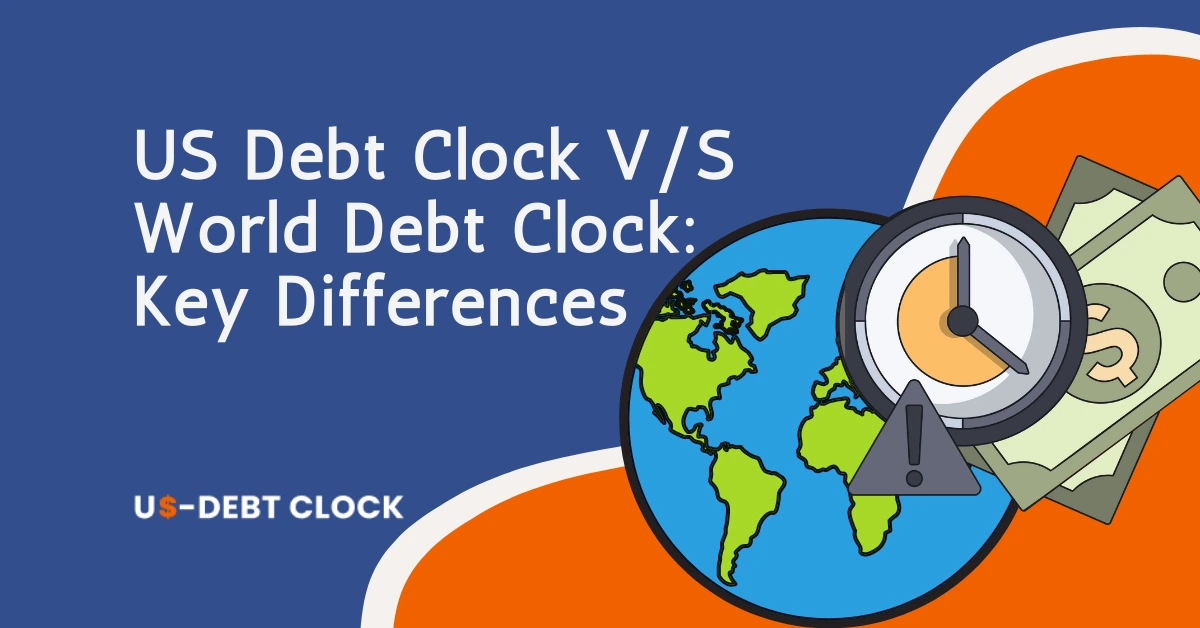What if we told you each American citizen owes over $100,000 in US National Debt?
Sounds scary, right? But it is the sad reality of the US Debt Clock per person. In early 2025, each US citizen would owe one hundred thousand dollars to the US if the national debt were to be divided equally among every citizen.
Even before the US National Debt really affects government policies, it affects you, be it you are a student paying student loans, an office employee saving for retirement, a freelancer managing your own budget, or a business person paying taxes.
Simply, US Debt Clock is a digital bank that keeps track of how much money the government has borrowed and needs to pay back. It is important to keep an eye on the US debt clock to be aware of the money we need to pay back.
As the US national debt continues to grow, itâs easy to feel frustrated to keep on seeing the numbers flashing on the US Debt Clock. It keeps on showing you how much money you need to pay if we all had to share the debt equally.
But hereâs the truth: each dollar that gets added to the US Debt Clock represents the added burden to each US citizen, and that includes you, too. In this blog, we will break down the concept of calculating the US Debt Clock per citizen and the immediate economic threat of rising per-person US debt.
You will discover if individual taxes can reduce the national debt. Keep on reading to learn how the national debt impacts you and if thereâs something you can do about it.
How is the US Debt Clock Per Person calculated?
The basic concept of calculating the US debt clock per person is to take the total amount of money the United States of America owes and divide it by the total number of US citizens to find out how much each individuals owe.
In early March 2025, the US debt per person was approximately $106,000, and it keeps on growing. But there are a few things you need to be clear about regarding the US debt clock per person.
US Debt Clock Per Person is a theoretical concept that assumes national debt is divided equally among each individual US population. The reality is that the burden of national debt falls more on taxpayers and future generations; not all citizens contribute equally to the US national debt; so itâs better if you find out where you stand.
US Debt Clock Per Person doesnât represent the amount you owe directly to the USA. It is purely a theoretical concept just to measure the national debt in ratio to population and does not mean everyone is personally liable for that amount.
The US Debt Clock per person is not a reflection of personal debt. The US national debt includes both public debt and intra-governmental debt. This amount does not represent your personal finances, and you shouldnât confuse it with your share of student loans, credit card bills, and mortgages; you still need to pay them.
The US Debt Clock Per Person is not a practical approach to US Debt Management, i.e., you are not required to pay a portion of the debt. The debt is managed as a part of broader fiscal plans and policies rather than on a per-person basis.
The increasing US Debt Clock per person is concerning, but it doesnât mean you are in an immediate debt-related crisis. The US national debt is a long-term issue that is tied to the US government and the governmentâs economic policies.
Is there an immediate economic threat of rising per-person US debt?
As you know, the US government has the ability to print its own currency and can manage debt to support economic growth. Excessive and unmanaged debt is harmful to the USA & citizens, but rising national debt doesnât always affect the economy negatively. The investments that are made in infrastructure or education are also part of the national debt, which in the long run helps to generate a high GDP, ultimately helping to reduce the debt-to-GDP ratio.
The US is the issuer of the worldâs reserve currency, and it has an important position in the global economy. This power allows the USA to borrow at a lower interest. The high debt-to-GDP ratio shows the challenges in the long run, but for the short run, the USAâs ability to service debt and the USAâs economic flexibility still withstand the investorsâ willingness.
The American Federal Reserve plays a role in controlling interest rates, and it does it accordingly to manage the increased borrowing. In the current situation, when the interest rates are low, private borrowing is not overshadowed by government borrowing. In contrast to public belief, in such situations, the government can keep on borrowing without dramatically increasing interest rates.
USA's debt is not entirely generational debt, though it is true that some of the debt is surely going to be passed on to future generations. Part of the USA's debt is invested in infrastructure and education. These investments take time to flourish, and so does the growth of future generations. If everything goes according to the investment plans, future generations can be less burdened by the national debt.
The American Federal Reserve controls inflation with monetary policies, so a well-managed debt-to-GDP ratio helps to invest in long-term productivity. As the USA has not experienced runaway inflation despite rising debt levels, we can hope for better management of the national debt.
Can Individual Taxes Reduce US National Debt?
You may wonder if individual taxes can reduce the national US debt. The weird part is that individual taxes are unlikely to reduce the national US debt alone. You simply need to hold on to government policies and hope for the best before the rising national debt disturbs your private life directly.
Conceptually, the higher tax payment means greater revenue generation for the US government, but the thing is that the USâs national debt is in trillions of dollars. Even after significant collection of taxes, there needs to be greater economic changes to match the debt level.
Understanding Your Share of the US National Debt
The US Debt Clock is a symbolic representation of the national debt in comparison to US citizens. So, as a US citizen, it's up to you how you perceive it. Some US population believe it is a ticking bomb that could collapse the economy, while others believe the government will continue to handle it as it has.
The US Debt Clock per person is not precisely a financial obligation to citizens, but rather an awareness about the governmentâs debt. It is here to spark concern about the growing national debt and its impact on the future. We need thoughtful economic policies to move forward.
Understanding your share of the US national debt is not simply about numbers; it is about how these numbers impact your financial plans. So it's better if you keep on tracking the US National Debt for no new sudden economic surprises.
FAQs
How much is the US Debt per person?
At the start of March 2025, the US Debt per person is approximately $108,000.
How much is the US Debt per hour?
Considering the average growth rate, the US Debt per hour is $17 per hour per person.
Who owns most of Americaâs debt?
Federal Reserve System holds most of Americaâs debt, i.e, $5.24 trillion.
What is the US's net worth?
The USâs net worth is $200 trillion, considering both liabilities and assets.
Is the US economy strong or weak?
The US economy has both economic strengths and vulnerabilities.
What country has the best economy?
Switzerland, Germany, and Singapore have the best economies.



